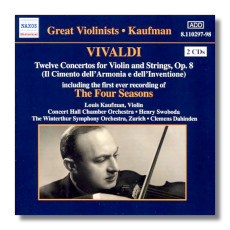
The Internet's Premier Classical Music Source
Related Links
- Vivaldi Reviews
- Latest Reviews
- More Reviews
-
By Composer
-
Collections
DVD & Blu-ray
Books
Concert Reviews
Articles/Interviews
Software
Audio
Search Amazon
Recommended Links
Site News
 CD Review
CD Review
Antonio Vivaldi

12 Concertos for Violin & Strings, Op. 8 (1725)
Il Cimento dell'Armonia e dell'Invenzione
- Violin Concerto #1 in E Major "La primavera", RV 269
- Violin Concerto #2 in G minor "L'estate", RV 315
- Violin Concerto #3 in F Major "L'autunno", RV 293
- Violin Concerto #4 in F minor "L'inverno", RV 297
- Violin Concerto #5 in E Flat Major "La tempesta dì mare", RV 253
- Violin Concerto #6 in C Major "Il piacere", RV 180
- Violin Concerto #7 in D minor, RV 242
- Violin Concerto #8 in G minor, RV 332
- Violin Concerto #9 for Oboe & Strings in D minor, RV 454
- Violin Concerto #10 in B Flat Major "La caccia", RV 362
- Violin Concerto #11 in D Major, RV 210
- Violin Concerto #12 for Oboe & Strings in C Major, RV 449
Louis Kaufman, violin
Concert Hall Chamber Orchestra/Henry Swoboda (#1-4)
Winterthur Symphony Orchestra/Clemens Dahinden (#5-12)
Naxos Historical 8.110297-98 ADD monaural 2CDs: 63:51, 62:43
It is hard to believe that there was a time in the not so distant past when Vivaldi's The Four Seasons was an unfamiliar work. Now it is almost inescapable in restaurants and in classy shopping malls, and it seems that new recordings come out on a monthly basis. Here is its very first recording, made in New York City in 1947 when the set of four concertos was terra incognita. The record won the Grand Prix du Disque, and the rest, as they say, is history. A few years later, after Kaufman and his wife had moved to Europe, he recorded the other eight concertos which make up Vivaldi's Opus 8 in Switzerland. (To do so, first he had to track down the published scores, which he found in a Belgian library.) The "Winterthur Symphony Orchestra," like the "Concert Hall Chamber Orchestra," was a pickup group, but both were comprised of fine professional musicians who could play anything you threw at them. In both cases, the LP label was Concert Hall – long defunct but fondly remembered by collectors who now are old enough to collect Social Security!
The Oregon-born Kaufman was a child prodigy, and he made an auspicious debut in New York City's Town Hall in 1928, when he was in his young twenties. Later, he moved to Hollywood, and recorded many movie soundtracks between 1934 and 1948. It was at the end of this period that Kaufman became associated with Concert Hall, and during his European years he became something of a peripatetic repertoire scout for the adventurous label, and a driving force in the general rediscovery of music by Antonio Vivaldi. Kaufman died in 1994, having had a career eventful enough for any two violinists.
These recordings are historically significant, of course, but they're not merely "good, considering." The period instrument movement was just a glimmer in a few musicians' eyes at this time, yet Kaufman and his ensembles play with more stylistic awareness than many of the great violinists have had in the decades since then. Everything sounds fresh and newly-minted… which, in a sense, it was. In the outer movements, nothing is exaggerated or thrown in our faces, and if the middle movements are played with more Romantic inflections than would generally be accepted today, there's no denying how effective these performances are. They also provide a link with older styles of violin-playing. Kaufman's use of portamento, for example, hearkens back to his experiences, as a youngster, making music with Mischa Elman and Efrem Zimbalist. One might say that these recordings sit on a summit, with the modern era on one side, and the traditions of the 19th century on the other.
The Four Seasons originally was released on 78-rpm discs; by the time the other concertos were released, LPs had become the standard format. To prepare this reissue, restoration engineer Anthony Casuccio had access to a panoply of commercial issues and test pressings; ultimately, source materials from the Kaufman Estate allowed him to achieve results which are quite good, a few sonic bobbles aside.
This is an indispensable set for anyone who loves Vivaldi, and who wants to know how we got where we are today. Indeed, Kaufman's Four Seasons has been inducted into the Grammy Hall of Fame (2002), and selected by the Library of Congress for its National Recording Registry (2003).
Copyright © 2005, Raymond Tuttle



















